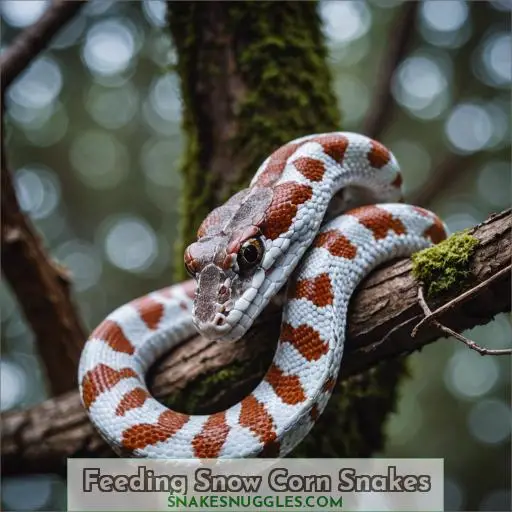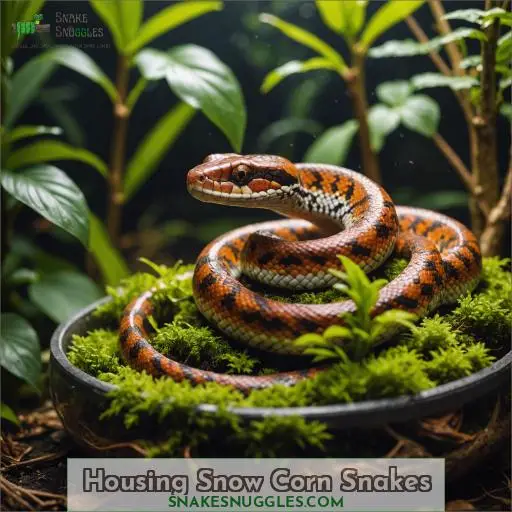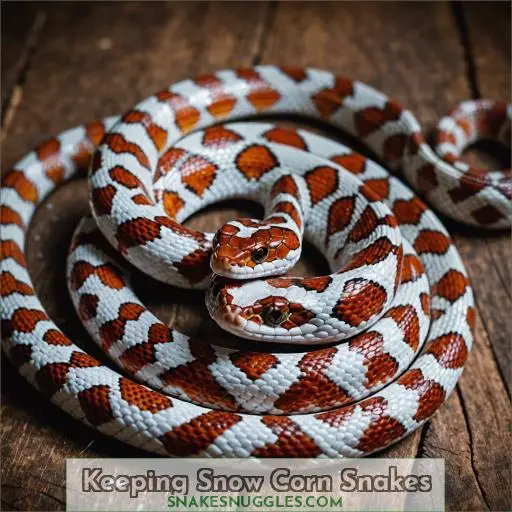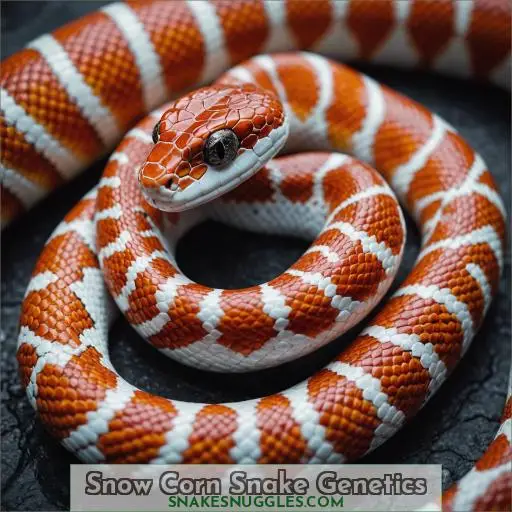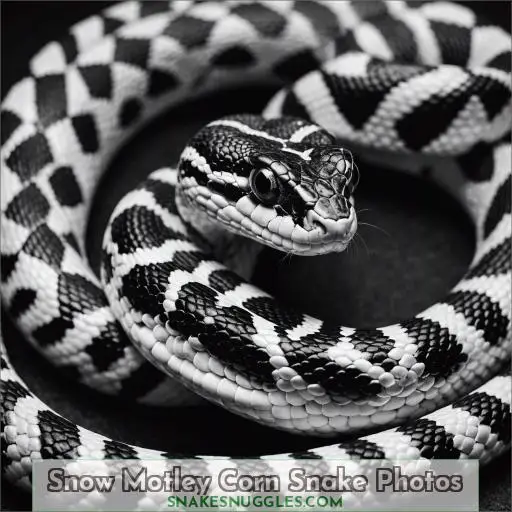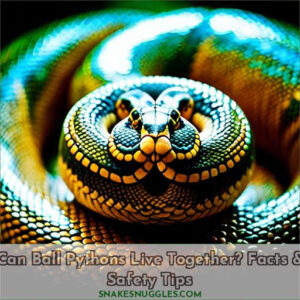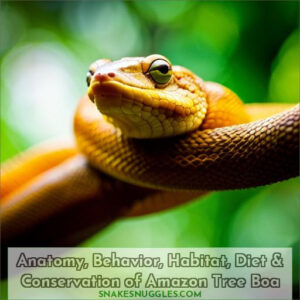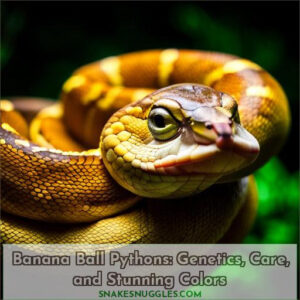This site is supported by our readers. We may earn a commission, at no cost to you, if you purchase through links.
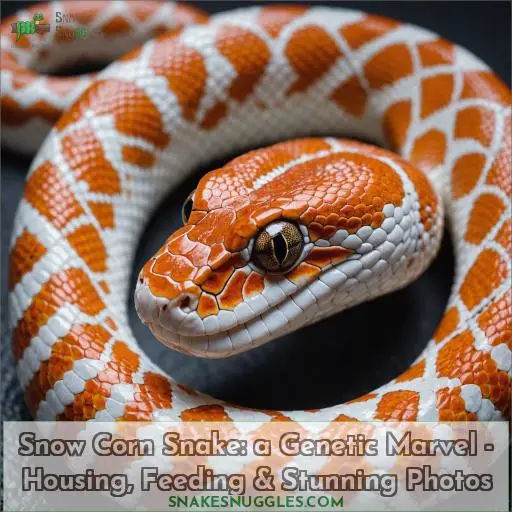 The snow corn snake is a genetically unique reptile with a striking appearance.
The snow corn snake is a genetically unique reptile with a striking appearance.
Its Aaaa Anaana Mmmm genotype results from combining albino, anerythristic, and motley traits through recessive inheritance.
Preserving morphs like this contributes to conservation.
You’ll feed defrosted mice or rats weekly, adjusting portion size and frequency as it matures.
House it in a 120x60x60cm vivarium with multiple hides, a moss-filled shed box, and large water bowl.
Maintain 60-70% humidity and provide plastic plants for privacy.
Want to see stunning snow corn snake photos spanning every life stage?
Table Of Contents
- Key Takeaways
- Feeding Snow Corn Snakes
- Housing Snow Corn Snakes
- Keeping Snow Corn Snakes
- Snow Corn Snake Genetics
- Snow Motley Corn Snake Photos
- Frequently Asked Questions (FAQs)
- How big do snow corn snakes get?
- Are snow corn snakes venomous?
- Where do snow corn snakes live?
- Do snow corn snakes turn yellow?
- What other morphs can I breed a snow corn to?
- How can I identify if my normal corn has hidden genes?
- What are the differences between blizzard, avalanche, and whiteout?
- How do I choose the right male to breed with my snow?
- What are some unexpected outcomes when breeding corn snakes?
- Conclusion
Key Takeaways
- The snow corn snake’s striking appearance is the result of a combination of recessive genetic mutations, including albino, anerythristic, and motley traits.
- Proper care for a snow corn snake involves providing a suitably sized vivarium with multiple hides, a moss-filled shed box, and a large water bowl, while maintaining 60-70% humidity.
- Feeding a snow corn snake involves providing a single defrosted mouse or rat weekly, adjusting portion size and frequency as the snake matures.
- Preserving unique morphs like the snow corn snake contributes to conservation efforts by expanding the gene pool and showcasing the incredible genetic diversity within the species.
Feeding Snow Corn Snakes
To nourish your snow corn snake properly, provide it with a defrosted mouse or rat once a week, ensuring the prey is appropriately sized and doesn’t exceed the snake’s widest body part. As the snake reaches maturity, move over to feeding every other week, offering small rats, chicks, or other suitably proportioned fare.
Feed Defrosted Mice or Rats Weekly
Feed your snow corn snake a single defrosted mouse or rat weekly. The prey size shouldn’t exceed the widest part of the snake’s body. Offer a variety of rodents like small rats, chicks, or other appropriately sized species to provide a balanced diet. Defrost the prey overnight in the fridge and bring it to room temperature before feeding.
Feed Every Other Week Once Snake Reaches Maturity
Once your snow corn snake reaches maturity, you can adjust its feeding frequency to every other week. This accounts for the natural growth rate variance in captive-bred snakes. Offer a dietary variety of appropriately sized prey like small rats or chicks, ensuring the prey doesn’t exceed the widest part of your 10-12 inch snake’s body.
Offer Small Rats, Chicks, or Other Appropriately Sized Prey
Once your snow corn snake reaches maturity, you can offer small rats, chicks, or other appropriately sized prey. This variety helps meet their nutritional requirements and supports healthy growth rates. Aim to feed every 7-14 days, adjusting frequency based on the snake’s size and appetite. Providing a diverse prey selection keeps your coral snow corn snake engaged and thriving.
Housing Snow Corn Snakes
For housing snow corn snakes, you’ll need a suitably sized vivarium of around 120 x 60 x 60cm.
Provide multiple hides for your snake to feel secure.
Include a moss-filled hide to facilitate shedding.
Make sure that you include a water bowl large enough for your snake to soak in.
Regularly clean the vivarium, decor, and water bowl to maintain a healthy environment.
Suitable Vivarium Size: 120 X 60 X 60cm
To create the ideal snow corn snake habitat, you’ll want a spacious 120 x 60 x 60cm vivarium. This size allows for proper temperature gradients and humidity levels. Use a substrate like aspen shavings that facilitates burrowing, and provide a mix of lighting options – from overhead heat lamps to under-tank heaters – to precisely control the environment.
Provide Multiple Hides for Safety and Security
Providing multiple hiding spots is essential for your snow corn snake’s security and safety. Strategically place a variety of hides throughout the enclosure, such as hollow logs, rock caves, and plastic foliage. This habitat enrichment allows your snake to feel secure, reducing stress and promoting natural behaviors. Carefully design the enclosure to meet your snow corn snake’s hiding requirements.
Include a Moss-filled Hide for Shedding
In addition to providing multiple hiding spots, include a moss-filled hide on the warm side of the enclosure. The moist sphagnum moss helps maintain humidity levels ideal for shedding, which occurs every 4-6 weeks for young corn snakes. This humid hide offers an alternative to aspen or cypress mulch substrates that can dry out quickly.
Provide a Water Bowl Large Enough for Soaking
Provide your snow corn snake with a large, shallow water bowl – at least 6 inches wide and 2 inches deep. This allows them to fully submerge and soak, which is essential for proper hydration and healthy shedding. Use a sturdy, non-porous material like ceramic or stainless steel to prevent tipping or contamination. Refresh the water 2-3 times per week.
- Make sure water bowl is large enough for full submersion
- Choose a durable, non-porous material like ceramic or stainless steel
- Refresh water 2-3 times per week for maximum hydration
- Soaking helps with healthy shedding and overall wellbeing
- Provide a reliable source of clean, dechlorinated water
Regularly Clean the Vivarium, Decor, and Water Bowl
Regularly clean the vivarium, decor, and water bowl to maintain a healthy environment for your snow corn snake. Replace soiled substrate, wipe down surfaces, and refresh the water bowl twice weekly. A moss-filled hide helps regulate humidity during the shedding process, so keep this hide clean and moist. Proper vivarium hygiene is key to your snake’s wellbeing.
Keeping Snow Corn Snakes
You’ll want to make certain your snow corn snake has multiple hiding spots throughout the vivarium to feel secure and comfortable. Providing a moist hide box filled with damp sphagnum moss is also recommended, as it helps the snake shed its skin properly during that process.
Require Multiple Hiding Spots Within the Vivarium
Corn snakes flourish when they have multiple hiding spots throughout their enclosure.
Place hides crafted from organic materials such as cork bark or smooth rocks in both the warm and cool ends.
Verify that the hides are sufficiently spacious for your snake to curl up comfortably inside.
Providing adequate hiding options enables your corn snake to feel secure and display innate behaviors.
Humid Hide Recommended for Shedding
Supplying a humid hide is essential for your snow corn snake’s shedding process. Strive for humidity levels around 60-70% within the hide. Use sphagnum moss or paper towels to cover the hide, and make sure it’s large enough for your snake to fully coil up inside. Place the humid hide on the warm side of the enclosure for easy access.
Use Plastic Plants to Provide Privacy
Plastic plants are a superb way to provide your snow corn snake with the privacy and concealing spots it desires. These artificial foliage pieces not only heighten the aesthetics of the habitat, but also create a sense of security for your slithery companion. Placing them throughout the territory allows your snake to retreat and feel at ease, promoting its overall well-being.
- Choose a variety of plastic plants in different shapes and sizes.
- Arrange the plants to create multiple hiding spots and visual barriers.
- Make sure the plants are securely anchored to prevent your snake from accidentally ingesting them.
- Regularly clean and maintain the plastic plants to keep the enclosure looking fresh and inviting.
Snow Corn Snake Genetics
The snow corn snake’s genetic code is a fascinating combination, represented by the genotype Aaaa Anaana Mmmm. This remarkable mutation results in a stunning visual display, with intricate patterns and striking colors that captivate snake enthusiasts and breeders alike.
Genotype: Aaaa Anaana Mmmm
The snow corn snake‘s genotype is a beguiling combination of recessive genes. It carries the aaaa (albino), anaana (anerythristic), and mmmm (motley) mutations, resulting in its striking appearance. This unique genetic makeup gives the snow corn its one-of-a-kind look, making it a true wonder among corn snake morphs.
Mutation: Combination
The Snow Corn Snake‘s unique appearance stems from a combination of recessive genetic mutations.
This hybrid marvel blends the albino and anerythristic traits, resulting in its striking white coloration and red eyes.
Inheriting these recessive traits from both parents, Snow Corns showcase the incredible genetic diversity within the species.
Preserving these captivating morphs can contribute to conservation efforts by expanding the gene pool.
Snow Motley Corn Snake Photos
Take a look at these stunning photos showcasing the genetic marvel that’s the Snow Motley Corn Snake.
From hatchling to adult, you’ll witness the intricate patterns and striking colors that make this snake a true beauty.
Whether it’s Ian Bradley’s eye-catching hatchling shots, AC Snakes’ adult female, or the vibrant images from breeders like Adam & Charlotte, JP.Corn Snakes, Corn Padrão, and Snake for Lovers.
Hatchling, Male: Ian Bradley
The hatchling Snow Motley corn snake photographed by Ian Bradley showcases the alluring qualities of this genetic wonder. Its refined features and striking patterning indicate the vivarium conditions necessary to foster this male snake’s development. With appropriate housing and nutrition, this striking hatchling will mature into an impressive adult deserving of AC Snakes‘ remarkable photography.
Adult, Female: AC Snakes
The adult female snow motley corn snake from AC Snakes is a true spectacle to behold. Her pristine white scales are adorned with the intricate motley pattern, creating a mesmerizing visual display. As she gracefully moves, her vibrant colors seem to sway, enchanting all who witness her beauty. This genetic marvel is a testament to the artistry of selective breeding.
Hatchling, Eye: Ian Bradley
The hatchling’s eye is a mesmerizing sight, with a striking pattern that beckons the observer in. Its dorsal stripe is sharp and well-defined, while the ventral pattern displays a subtle blend of colors. The head shape is sleek and elegant, suggesting the snake’s potential for growth and maturity. This hatchling is a true genetic marvel.
1 Month, Male: Adam & Charlotte – Www.acsnakes.co.uk
At just 1 month old, this male Snow Motley Corn Snake from Adam & Charlotte’s collection is a true charmer. Measuring 10-12 inches, he’s the perfect size for new owners looking to add an alluring captive-bred snake to their family. With safe, efficient FedEx overnight shipping, this little guy will arrive at your doorstep ready to settle into his new home.
1 Month, Female: Adam & Charlotte – Www.acsnakes.co.uk
At just 1 month old, this female Snow Motley corn snake from Adam & Charlotte’s collection exhibits the striking physical characteristics of the breed.
Her vivid coloration, with the distinct snow-white base and intricate motley pattern, is a demonstration of the breed’s alluring appearance.
These snakes thrive in captive environments and exhibit a typically peaceful disposition, making them sought-after companions for reptile enthusiasts.
4 Months, Male: JP.Corn Snakes
At 4 months, your male snow motley corn snake from JP.Corn Snakes is really starting to come into its own. The vibrant white and black patterning is simply stunning, and you can’t wait to see how its colors and markings develop over the next year. With proper care and feeding, this little guy is sure to be a real showstopper.
1 Year, Female: Corn Padrão
At one year old, this female Snow Motley Corn Snake from Corn Padrão is truly a sight to behold.
Her striking pattern and vibrant coloration make her an absolute stunner.
With proper care and feeding, you can expect this enchanting snake to thrive for many more years to come.
Her gentle temperament also makes her an excellent choice for experienced reptile enthusiasts.
1 Month, Female: Snake for Lovers
At just 1 month old, this female Snow Motley Corn Snake is a true sight to behold. Owned by the passionate team at Snake for Lovers, this hatchling already exhibits the stunning combination of genetic traits that make Snow Motley Corns so enchanting. With the right care and feeding, she’ll grow into a magnificent adult – a true wonder of nature.
- Enchanting color and pattern
- Gentle handling for optimal health
- Specialized housing and feeding needs
- Lifelong companionship with proper care
Frequently Asked Questions (FAQs)
How big do snow corn snakes get?
As the old adage says, Good things come in small packages. Snow corn snakes typically reach 4-5 feet long as adults, making them perfect for those wanting a manageable pet snake.
Are snow corn snakes venomous?
No, snow corn snakes are non-venomous pet snakes. They’re constrictors—snakes that wrap their bodies around prey to subdue it. As docile, captive-bred pets, snow corns pose zero threat when handled properly by responsible owners.
Where do snow corn snakes live?
You won’t find these intriguing beings roaming free; their natural home lies within our vivid imaginations, where we can provide a habitat designed to meet their special requirements.
Do snow corn snakes turn yellow?
No, snow corn snakes don’t turn yellow as they age. Their bright white color remains consistent throughout their lifespan, making them stand out from other corn snake varieties.
What other morphs can I breed a snow corn to?
You can breed snow corns with other morphs like ghosts, stripes, aneries, or combos like blizzard. Have a specific pairing in mind? Let me know the genetics, and I’ll give you the odds.
How can I identify if my normal corn has hidden genes?
To check for hidden genes, you’ll need to breed your corn and analyze the offspring’s patterns. Certain morphs only express when paired with a visual gene carrier. A reputable breeder can also perform genetic testing.
What are the differences between blizzard, avalanche, and whiteout?
As luck would have it, blizzard, avalanche, and whiteout are all terms describing varying degrees of whiteness in corn snakes – blizzard being the least white, avalanche more so, and whiteout the whitest variation.
How do I choose the right male to breed with my snow?
Select a male with complementary genetics and proven breeding success. Evaluate health, vigor, and temperament. Reputable breeders can assist with compatible pairings for desired traits.
What are some unexpected outcomes when breeding corn snakes?
Rolling the genetic dice when breeding corn snakes can yield unexpected surprises – leucistic, caramel, hypo, and more, each a one-of-a-kind wild card.
Conclusion
Like a vibrant tapestry, the snow corn snake‘s unique genetics weave a stunning pattern. Owning this marvel requires dedication: providing suitable housing, regular feeding, and care customized to its needs. By comprehending and meeting the snow corn snake’s requirements, you’ll guarantee its well-being and longevity, safeguarding this genetic masterpiece for future generations to appreciate.

